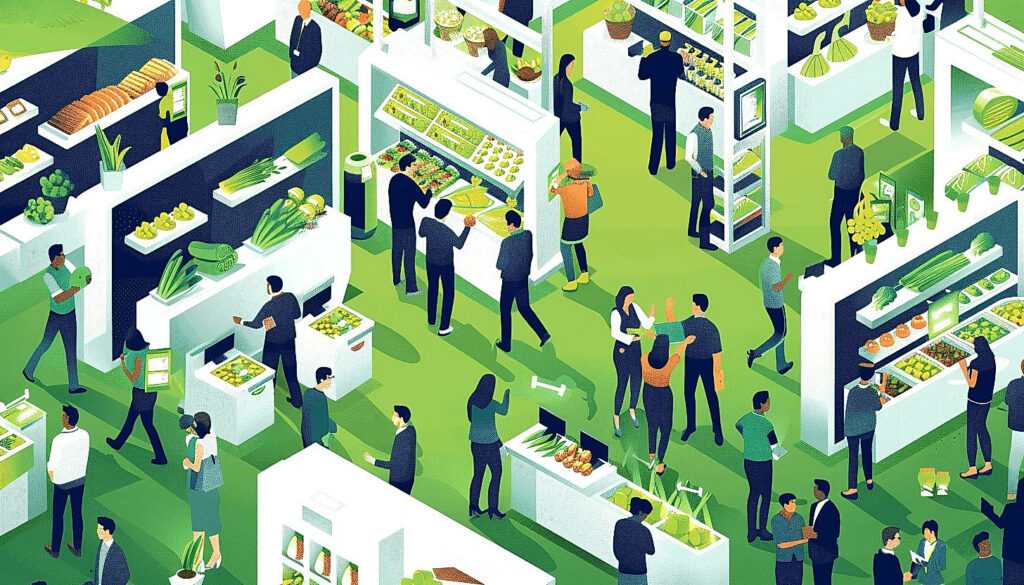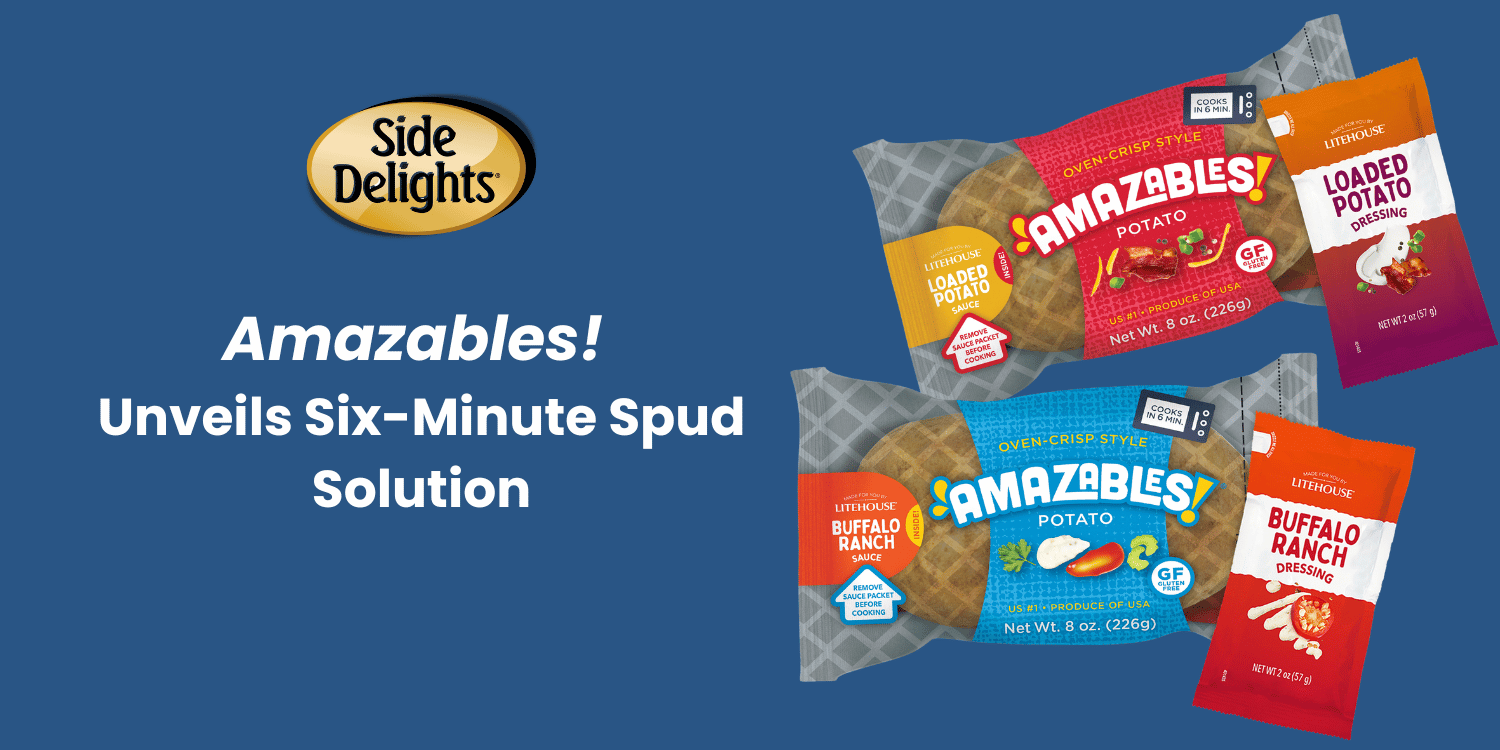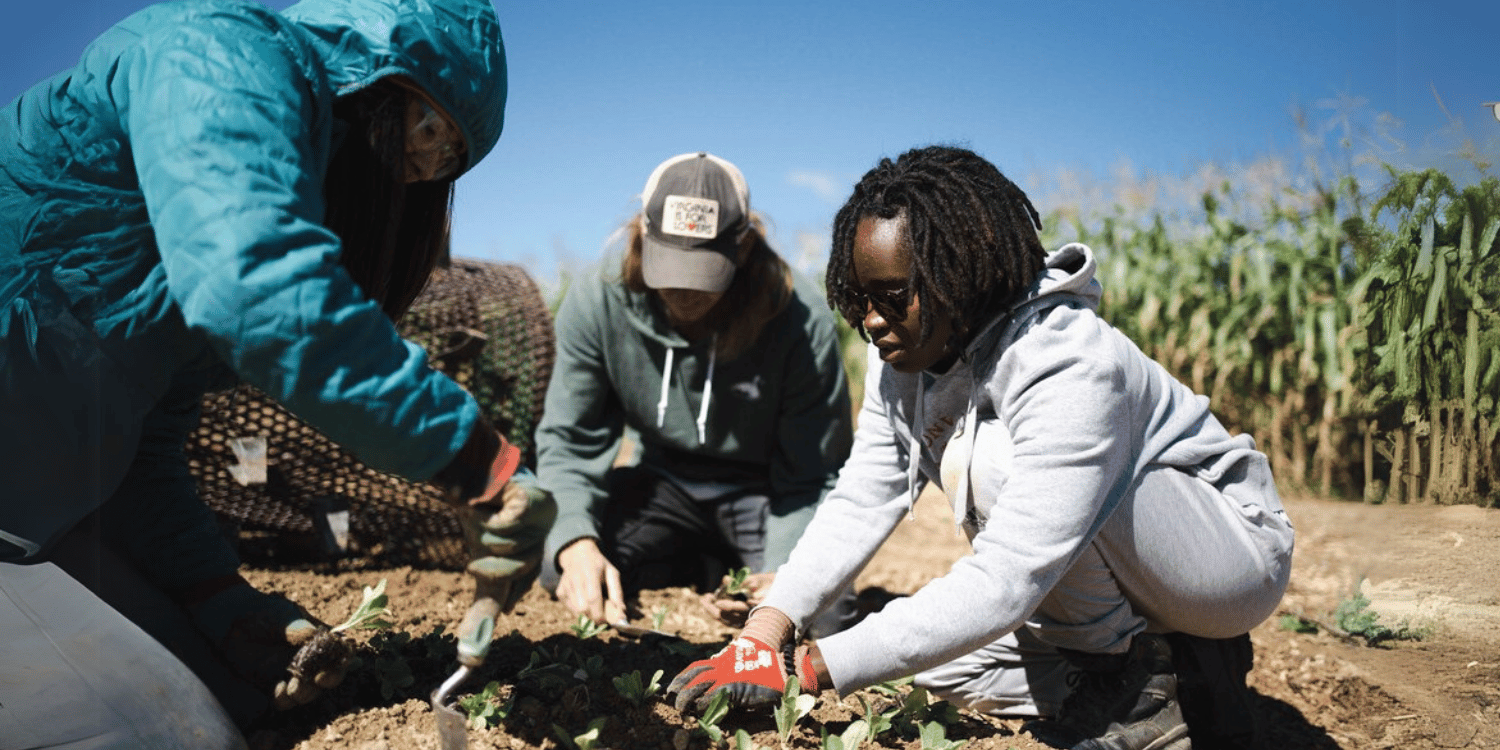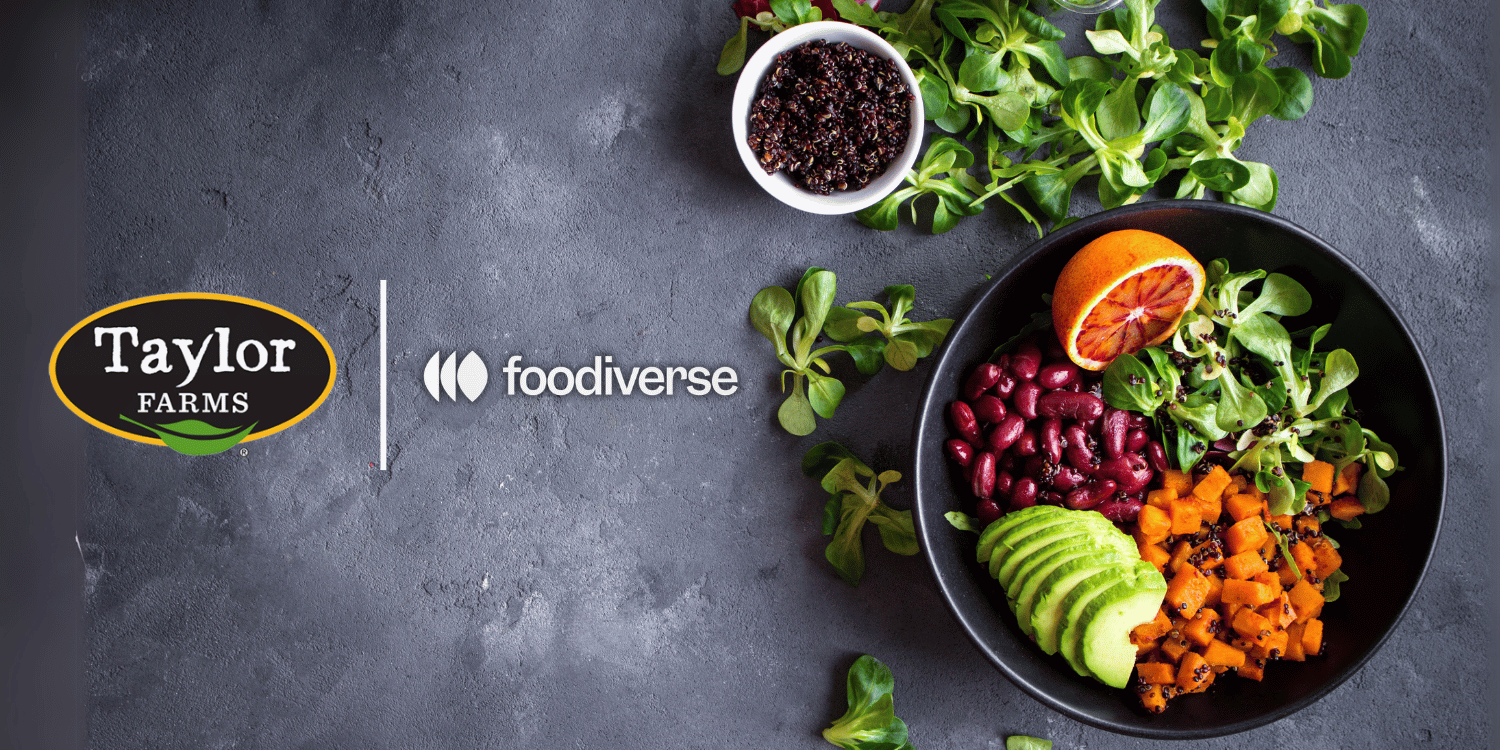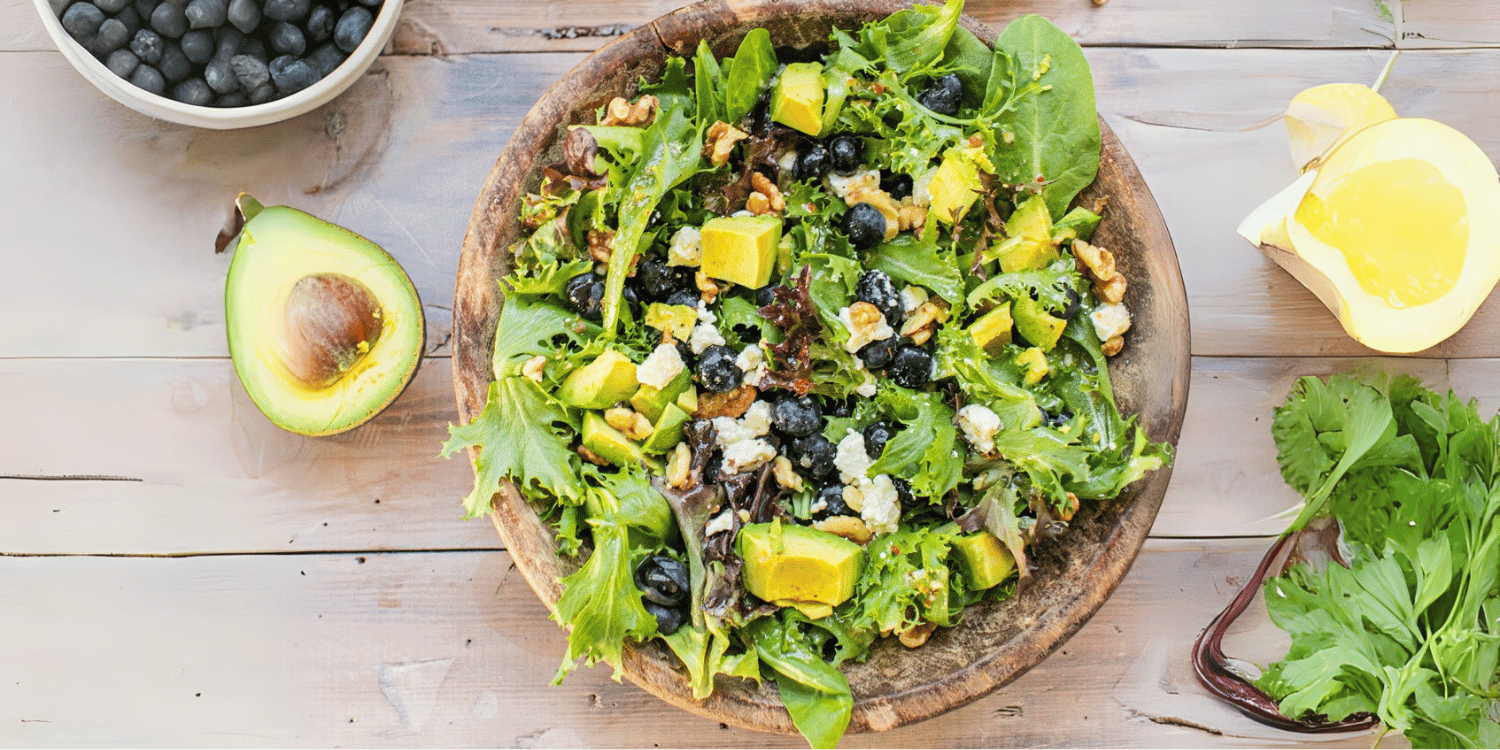Utilizing produce trade shows to secure retail partnerships begins with proper preparation that includes researching potential partners and tailoring your products or services to meet their needs.
In these trade shows, make sure to leverage on the opportunity by showcasing your best produce, emphasizing on their quality, sustainability, and consumer appeal.
Develop compelling booths and product presentations that attract retailers, focusing on your product’s unique selling points and market differentiators.
Networking is fundamental, as such, engage directly in meaningful conversations with potential retail partners, understanding their needs and how your business can provide solutions.
Ensure to follow up on leads after the shows, emphasizing the benefits of your product and expressing your interest in a future partnership.
Therefore, a successful strategy in trade shows contributes to lead generation and securing retail partnerships.
- Produce trade shows are a platform to secure retail partnerships.
- Research, product tailoring, and effective showcasing are crucial for success.
- Compelling booth presentation and unique selling points aid in attracting retailers.
- Networking during and follow-ups after trade shows are key strategies.
- These strategies can lead to substantial benefits in collaborative logistics.
While we’ve discussed some key takeaways on how to effectively use produce trade shows to secure retail partnerships, our article doesn’t stop here.
We’ll also explore other important elements of business strategy in the context of trade shows. This includes calculating return on investment, the importance of timing, and even designing follow-up strategies.
These valuable insights can help optimize your trade show participation and secure those crucial retail partnerships.
Stay with us as we break down these complex topics into simple, easy-to-understand concepts that can contribute to your business success.
Contents
- What are Produce Trade Shows?
- Why Attend Produce Trade Shows?
- How to Research Potential Partners?
- Tips to Tailoring Products for Retailers
- Showcasing Best Produce: How-to Guide
- Essentials for Compelling Booth Presentation
- Unique Selling Points to Highlight
- How to Network at Trade Shows?
- Ways to Follow-up After Trade Shows
- Benefits of Successful Trade Show Strategies
- The Bottom Line
What are Produce Trade Shows?
In Short: Produce trade shows are professional events that unite members of the agriculture, food, and retail industries for showcasing products, networking, and fostering business transactions. They offer myriad opportunities, such as exhibiting goods, hearing keynote speeches, attending workshops and seminars, engaging in informal networking events, and provide a valuable platform for learning industry trends and building partnerships.
Produce trade shows are events that bring together professionals from the agricultural, food, and retail industries in a concentrated, exhibition-style arena. Here, growers, manufacturers, suppliers, retailers, and distributors have the unique opportunity to network, build relationships, showcase products, and make deals.
They’re a collaborative marketplace, wouldn’t you say? Acting as a platform for interaction and business transactions among the myriad professionals involved in the produce industry, they offer opportunities that are hard to find in any single location elsewhere.
Trade shows differ greatly in their size, scope, and focus. Some are huge, accommodating hundreds of exhibitors and attracting attendees from all over the world while others are smaller, more specialized events, don’t you think?
But what exactly happens at these events, you may ask. Networking, lots of it. These events essentially act as a fertile ground for forming new relationships and strengthening existing ones within the trade community.
The highlight of the event is often the exhibition floor, where exhibitors can display their produce and related products. This is the time when you can really see the variety and innovation in the industry, isn’t it exciting?
Prior to diving into what these shows often comprise of, let’s list down some elements commonly present at these shows:
- The Exhibition Floor – The main area where exhibitors display their goods and offerings.
- Keynote Speeches – Professionals, industry leaders and innovators share their insights and future predictions.
- Workshops and Seminars – Where attendees learn about the nuances of the industry, new trends, and skills needed.
- Networking Events – Social opportunities for attendees to interact, form partnerships and possibly close deals.
These are just the tip of the iceberg, the actual experience of a produce trade show is beyond comparable. Furthermore, they might also offer workshops and seminars where you can learn about the latest industry trends, technological advancements, and innovative techniques.
Keynote speeches by industry leaders and pioneers provide attendees with valuable insights about the state of the industry, as well as its potential future trajectory. Learning opportunities like these are priceless, wouldn’t you agree?
Apart from this, it’s not all business, trade shows also host networking events like cocktail parties and dinner where professionals can interact in a less formal setup. You can form partnerships and business deals while enjoying the ambiance and refreshments, can’t you?
In essence, produce trade shows offer immeasurable value to exhibitors and attendees alike, providing a unique environment to conduct business, gather insights, and foster valuable connections. Doesn’t this already sound like a matchless opportunity?
Why Attend Produce Trade Shows?
In Short: Attending produce trade shows provides a platform to learn about new industry trends, connect with other professionals, and showcase your products to potential customers. The value gained from discovering innovations, forging business alliances, and gaining firsthand industry experience is invaluable to businesses looking to thrive in the marketplace.
Often, the question arises in the minds of entrepreneurs, Why attend a produce trade show?
Well, the simple answer lies in four words:, to discover, discuss, demonstrate, and deal.
Trade shows serve as great platforms to discover new trends, techniques, and technologies within the industry.
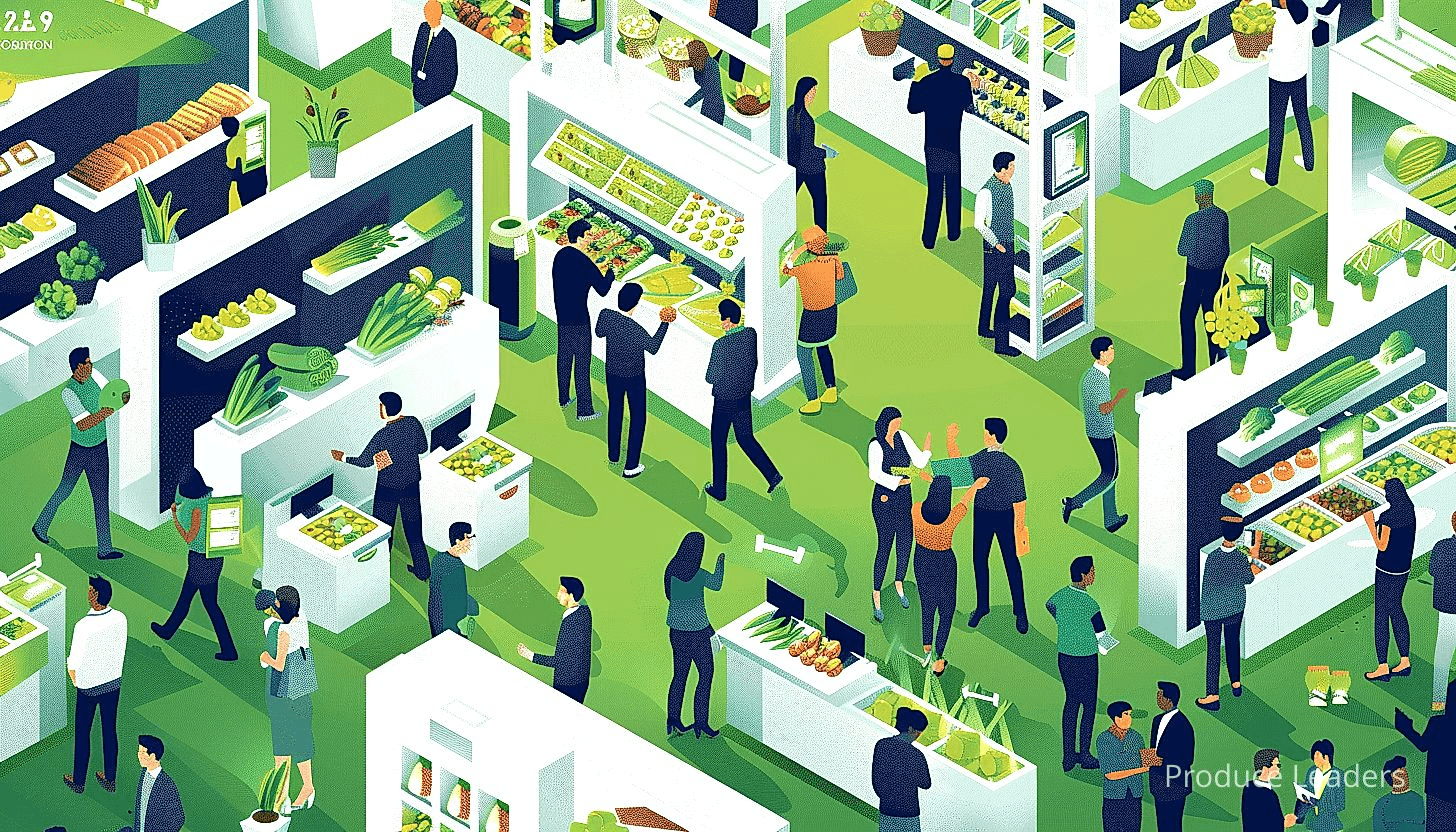
By keeping an eye on the floor, one can gain insight into what’s hot and what’s not. Long sentence – And, are there any fresh approaches or innovative products that can give you a competitive edge in the market?
Moreover, these events provide an avenue to interact with industry veterans and thought leaders.
Conversations with these individuals can be a goldmine of knowledge.
In addition, they also offer ample opportunities to discuss potential partnerships with retailers and wholesalers.
One can meet like-minded people and forge alliances that may eventually translate into business deals.
However, it’s not just about taking—it’s about giving too.
An exhibitor also has the chance to demonstrate their product portfolio to potential customers.
This is why it’s beneficial to attend produce trade shows:
- Discover latest industry trends and innovations
- Discuss potential partnerships with retailers and wholesalers
- Demonstrate your product portfolio to potential customers
At a trade show, you can directly interact with shoppers and sample your products.
Showing your products in person can be far more convincing than any advertisement or product description.
In terms of dealing, these events facilitate business transactions on the spot.
And the face-to-face negotiation often influences the decision of buyers positively.
A trade show is essentially an environment where the market comes to you.
Rather than cold-calling or emailing retailers, you can effortlessly connect with them at a single venue.
These platforms also provide an opportunity to demonstrate your commitment and passion toward the industry.
A regular presence at trade shows indicates that you are proactive and serious about your business.
Additionally, it’s an opportunity to learn from the successes and failures of other exhibitors.
Doesn’t everyone learn better from real examples rather than just theoretical information?
Lastly, and quite importantly, partaking in these trade shows offers one thing that’s invaluable—experience.
Each participation adds to your experience and helps in refining your trade show strategy for the future.
Pro Tip: Attending produce trade shows is crucial as they are platforms to discover new trends, discuss potential partnerships, demonstrate your products to potential customers, and facilitate on-spot business transactions.
Hence, for businesses aiming to expand and thrive in the world of produce, it becomes imperative to attend these shows.
It’s time to embrace the myriad opportunities that these produce trade shows offer, and ride the wave to success.
How to Research Potential Partners?
In Short: Researching potential partners for produce trade shows involves understanding their business culture, target markets, financial stability and growth potential. Continuous and evolving research lays the foundation for securing profitable and aligned retail partners.
When walking into produce trade shows, be armed with a clear understanding of the retail partners you wish to secure. But how can you be certain about the potential partners?
Research is key here. It requires deep understanding of what you’re looking for and why.
Understanding the retail landscape should be a priority. Are your potential partners national retail chains or small-scale farmers markets?
What scale of retail outlets are you targeting? It’s no small decision.
Spend ample time to understand the culture of potential partners. How do they operate? What are their product preferences?
It’s important to comprehend the belief system driving their operation. Does it align with yours?
Identifying the target market of your potential partners is key. Their primary customers should be your target market as well.
Does the potential partner serve the same consumer base as you aim to serve? Are their customers your potential customers too?
Look at their current inventory. What other brands or products do they carry?
Can your products get lost in their large inventory? Or do they complement their existing stock?
Before we dig in deeper, here are few more considerations for your research:
- Does the potential partner value organic produce?
- What kind of working relationships does he believe in?
- Does their business strategy align with your long-term plans?
Financial stability of the potential partner is of immense importance. Are they a stable, profitable business?
After all, entering into a partnership with an unstable entity isn’t something you’d want. Need I say more?
Check out their reputation in the market. Are they known for good business ethics? What’s their customer satisfaction level?
The consumer sentiment about the potential partner could carry enormous weightage. Wouldn’t you agree?
Explore the potential for growth. Do they have plans for business expansion?
Does this include opening more retail locations? Something to ponder, indeed!
What are their distribution channels? How do they handle logistics?
A potential partner with a robust distribution network could be a great asset.
Try to understand their preferences. Do they require specific packaging or labeling?
Your compliance with their specific needs could be what clinches the deal. How flexible are you in this regard?
Pro Tip: When researching potential partners for your business at produce trade shows, ensure to understand their retail landscape, culture, target market, value for organic produce, working relationships, long-term goals, financial stability, reputation, growth potential, distribution network, and specific preferences.
Above all, get a sense of the people running the show. After all, businesses are made by people, not just by products, right?
Don’t forget, research isn’t a one-time thing. It should be continuous and evolving. Isn’t adaptability the key to survival?
Tips to Tailoring Products for Retailers
In Short: Understanding the retail market dynamics is crucial for customizing products that meet retailers’ specific needs. Utilize a tailored approach, focusing on product packaging, pricing strategy, product uniqueness, and effective promotion, and maintain constant communication with retailers to form lasting partnerships.
To understand how to customize products for retail, one needs to grasp the dynamics of the retail market. It enables you to design and promote products that meet the unique needs of retailers.
Start by knowing your target retailers and the customers they serve. Does your product blend with their market? What changes can improve your product’s fit perfectly for the retailers?
You’ve researched your target retailers, right? And you understand the demographic their customers fall into?
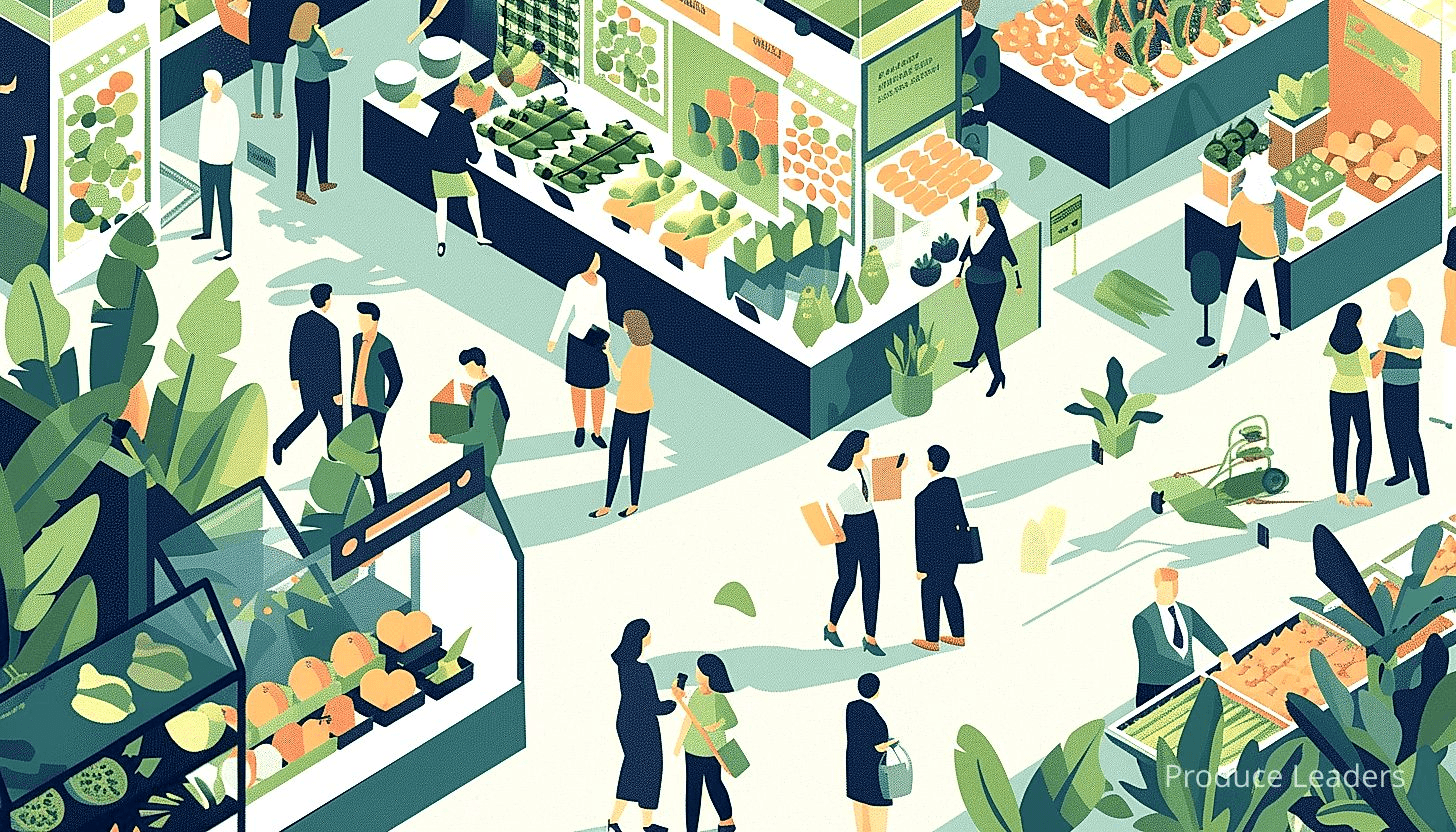
Consider the specific requirements of each retail outlet. This allows you to customize your products and approach for each retailer, thereby increasing your odds of securing a partnership.
Now let’s take a look at some essential tips.
- Product packaging: This should be attractive, functional, and should communicate brand values effectively.
- Price-point strategy: Determine whether low-costing or premium pricing aligns best with the retailer’s customer base, then tailor your product to fit.
- Product uniqueness: Differentiate your products from competitors. Unique, hard to replicate features draw retailers.
- Effective Promotion: Develop compelling promotional materials that speak to the retailer’s customer base.
Sounds helpful, right? But does product tailoring end here? Not at all!
It’s a continuous process. Stay committed to periodic evaluations and adjustments. And remember, feedback is crucial. More importantly, remember to act on it.
Are trade shows just about displaying products? Or is there more in the offing?
Trade shows offer a platform to meet and interact with potential retail partners. Make the most of such platforms!
Pitching your product to retailers on a trade show floor needs careful planning. What is the unique selling proposition (USP) of your product? Can you articulate this effectively to potential retail partners?
Constant communication maintains and strengthens retail partnerships. Set up regular check-ins, ask for feedback, and be responsive to retailers’ needs.
It’s not just about securing partnerships — nurturing them is just as crucial. Making customers happy should be the ultimate goal. After all, isn’t that everyone’s primary purpose in business?
Are you ready to form lasting retail partnerships? To tailor products that make customers happy?
Showcasing Best Produce: How-to Guide
In Short: Successfully showcasing produce at trade shows requires strategic presentation, offering sample tastes, detailed information and interactive display. Careful produce selection, attention to visual appeal, and consistent engagement can form lasting impressions that secure retail partnerships.
In the competitive world of produce trade, securing retail partnerships can hinge on effective showcasing at trade shows. Utilizing your display to highlight the desirability of your goods is an absolute necessity.
Firstly, you need to curate your selection wisely.
It’s not about brining every type of product you produce.
Rather, pick the most visually appealing and popular items.
Keep in mind that quality beats quantity every time, right?
Now, onto some effective measures to consider when creating a standout showcase:
- Presentation: Your fruits and vegetables should be immaculately clean and styled strategically.
- Sampling: Taste often sells, so have samples of your best produce available.
- Information: Provide intriguing and documented information about your produce – its origin, growing conditions, unique traits, and more.
- Interactivity: Humans are sensory creatures and engaging multiple senses can aid in making a lasting impression.
Now, let’s dig in a bit deeper into some of these ideas, shall we?
Regarding presentation, you know how we eat first with our eyes, don’t you?
That being said, your produce should be displayed artistically and eye-catchingly.
Consider using beautiful containers, like wood crates or handmade baskets that enhance visual appeal.
Effective lighting can also highlight the vivid colors of your produce, making it pop and attract attention.
Sampling is a classic sales technique that works particularly well in the food industry.
By offering a taste sample, you allow customers to test the quality firsthand.
Wouldn’t you be more likely to buy a product you’ve already tasted and liked?
However, never underestimate the power of information!
Knowing where and how your produce is grown can make it much more appealing.
You’d want to know where your food comes from, wouldn’t you?
If your produce has a unique backstory or cultivation process, be sure to include those details.
Knowledge is power, and can sometimes be the difference that closes the deal.
Finally, integrate as much interactivity as possible into your display.
Could you incorporate a touch screen with short videos about your farm?
How about a mini-greenhouse with examples of your crops growing?
Such elements can turn a basic booth into a mini-experience.
Important: In the competitive world of produce trade, it’s crucial to strategically showcase your most visually appealing and popular items, and remember that quality beats quantity; your presentation should be immaculate, consider offering samples, provide detailed and intriguing information about your products, and incorporate interactivity to leave a lasting impression long after the trade show is over.
Let me tell you, it goes without saying, if you setup your produce showcase with strategic thought, careful selection, and attention to detail, your chances of securing those much-coveted retail partners will significantly increase.
I want you to remember, the goal is to not just showcase your produce, but to create an impression that lasts long after the trade show is over.
Essentials for Compelling Booth Presentation
In Short: A successful trade show booth presentation requires integrating your unique brand identity, creating succinct yet powerful messages and engaging visuals, and using interactive elements. It should also focus on creating meaningful relationships resulting in lucrative partnerships, with a welcoming team and thoughtful layout design.
At the heart of any successful trade show participation is an effective booth presentation.
Designing a compelling display demands creativity, planning, and an understanding of your brand’s unique strengths.
But, how exactly do you create an impactful booth that attracts potential retail partners?

Maybe you are pondering over this right now.
This section is committed to providing you with practical advice on how to turn your booth into a magnet for potential retail partnerships.
Please don’t forget, the aim is not just to attract attention.
The ultimate goal is to create meaningful conversations and forge relationships that result in lucrative partnerships, right?
Brand coherence is an essential aspect of your booth’s presentation.
Your booth should resonate with your brand’s identity, showcasing your unique traits and values.
I want you to remember, a booth that screams “generic” will be neglected in an arena where hundreds of companies are vying for attention.
Let me tell you, define your brand identity and integrate it seamlessly into your booth’s design.
Next, let’s talk about your messages.
Messages should be succinct, yet powerful, capable of attracting attention and provoking discussions.
Too much information can be baffling, while very little might not amount to interest.
Bear in mind, a balanced approach is needed.
Certain elements must be prioritized when setting up your booth; let’s highlight the most important ones:
- Clear branding: Your brand’s logo, name, and tagline should be easy to spot. Never let your booth be mistaken for another brand’s.
- Effective lighting: Shadows, dark areas or overly bright spots can be off-putting. Use professional lighting equipment to illuminate your booth appropriately.
- Engaging visuals: Relevant, striking visuals are important. This isn’t merely about eye-candy; engaging visuals can make products easier to understand and remember.
Have you considered interactive elements?
Interactive presentations or demonstrations not only attract attention but also foster a sense of engagement and ownership.
Why not incorporate AR or VR elements? You might find this gimmicky but buzzing trends like these can reel in curiosity and footfall to your booth.
My, oh my, aren’t we forgetting the pivotal role of body language and communication skills?
The members of your team should be welcoming, friendly, and prepared to answer inquiries or engage in discussions.
It’s important to remember, first impressions count.
And yes, they are often steered by non-verbal cues.
Finally, consider the layout of your booth.
Is it welcoming? Is the flow natural? Can people easily access product displays and informative materials?
Pro Tip: Integrate your brand identity seamlessly into your booth’s design to stand out from the crowd and attract meaningful retail partnerships.
Sometimes, we forget that the simple rearrangement of space can make a world of difference in making one feel more welcomed.
Let me tell you, harness these insights and strive to create a booth compilation that secures the retail partnerships you aspire for.
Unique Selling Points to Highlight
In Short: When attending a produce trade show, exhibitors should highlight the unique selling points of their products such as exceptional taste, sustainable farming practices, quality assurance, provenance, and exclusivity. This not only creates interest and effectively positions your brand, but also instills confidence in potential retail partners about the value of your products.
When attending a produce trade show as an exhibitor, showcasing the unique features of your produce is paramount.
What is it about your produce that sets it apart from everything else on the market?
Is it the exceptional taste attributed to time-honored growing techniques?
Or perhaps it is your commitment to sustainable farming practices that make your products extra special?
Whatever the unique selling points, these should be brought to the forefront during the interaction with potential retail partners.
Before we dig in into specific unique selling points to highlight, let’s understand why these are crucial.
- Creates interest: A unique selling point piques the interest of potential retail partners as they are constantly searching for products that are distinct from their current offerings.
- Positions your brand: It helps in effectively positioning your brand in the saturated market and sets the tone for your brand’s story.
- Bolsters buyer trust: When you clearly communicate what sets your produce apart, it instills greater confidence in buyers about the quality and value of your products.
One of the essential unique selling points to highlight is the quality assurance of your products.
Quality means different things to different people – to some, it could be taste, to others, it could be the health quotient.
You need to make sure that your understanding of quality aligns with that of your potential retail partner.
The provenance of your produce is another unique selling point that carries significant weight.
Are your products grown locally, contributing to the local economy?
Do they come from a specific region known for producing the best kind of that particular produce?
Sharing these stories adds intangible value to your products and helps establish a connection with potential partners.
Consider also speaking about your farming processes.
Are you engaging in sustainable farming practices, using less water, avoiding harmful pesticides, promoting biodiversity, or espousing fair labor practices?
These factors are increasingly important for today’s conscious consumers and hence, attractive to retailers.
Lastly, leveraging on the exclusivity of your products can work wonders.
Are your products exclusive varieties, only found in certain regions?
This is a beautiful way to draw retailers’ attention and make them interested in partnering with your brand.
Essentially, highlighting these unique selling points is not about boasting.
Important: When attending a produce trade show as an exhibitor, it’s crucial to showcase the unique selling points of your produce, such as exceptional taste, your commitment to sustainable farming, quality assurance, the provenance of your products, and the exclusivity, to create interest, position your brand, bolster buyer trust and potentially foster long-term retail partnerships.
It’s about providing valuable information to potential partners, helping them make informed decisions.
And possibly setting the stage for long-term retail partnerships that benefit both parties.
How to Network at Trade Shows?
In Short: Effective networking at trade shows involves strategic planning, a compelling pitch, genuine engagement, prompt follow-ups, and showcasing your business’s uniqueness. This not only bolsters personal engagement with potential partners but also increase chances of forging significant retail partnerships.
One could argue that effective networking is the lifeblood of any successful trade show experience. You might be wondering, “What strategies can I employ to maximize networking opportunities at trade shows?”
First and foremost, it involves strategically planning your approach. Go through the exhibitors’ list and identify potential retail partners you’d like to connect with. Is it crucial to do the homework first? Absolutely!
Let’s look more deeply into a few noteworthy tips you can utilize as part of your networking strategy. Don’t forget, your objective is to secure retail partnerships.
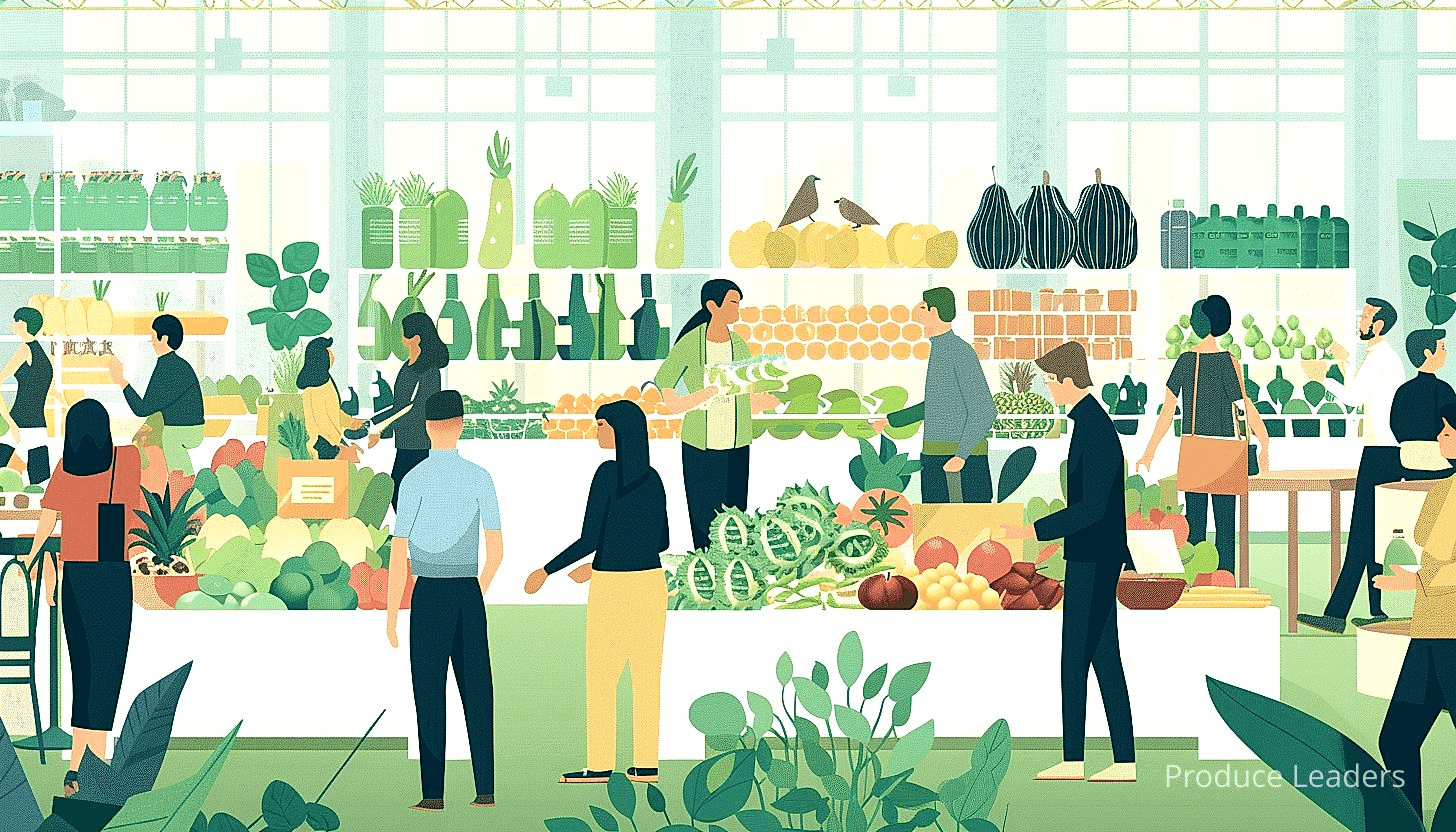
Here’s a quick summary of key points that might help:
- Prepare a compelling pitch: Tailor your presentation to echo the needs, objectives, and interests of potential retail partners.
- Be genuine and attentive: Engage in active listening — ask considerate questions and show genuine interest in their responses.
- Follow up promptly: Aim to reconnect with the contacts you made at the trade show within 48 hours.
Does the thought of starting a conversation with a stranger sound intimidating? Don’t worry, numerous professionals feel the same way. Potential partners are also there with the same intent — to network and forge connections. Burst the bubble, approach them, and start a conversation.
First impressions can be lasting. Ever heard about the impact of non-verbal communication? Your attire, body language, and even your demeanor speak volumes about you. Before you open your mouth, you’ve already sent a plethora of signals. Therefore, present yourself and your organization in the best possible light.
The essence of securing retail partnerships at trade shows is not just exchanging business cards. It’s about developing connections and nurturing them into meaningful partnerships. Is it easy? Not so much. But, with practice and a clear strategy, you will get better at it.
After all, a professional conversation is an exchange of information, just like a casual chat with a friend. Being inquisitive about their business, sharing common challenges, discussing market trends, or even talking about a seminar at the trade show are wonderful conversation starters. Do these sound like typical business-setting topics? They are.
A good way to make people remember you is by showcasing what’s special about your business. How can you make your product stand out? Show its uniqueness, share stories about its creation and development, or dig in into how it solves a particular problem in the market.
Pro Tip: To effectively network at trade shows, strategically plan your approach, be genuine and attentive, follow up promptly, and create a compelling pitch that aligns with the needs and interests of potential retail partners.
Also, attending seminars, workshops, and informal get-togethers at the trade show might present additional networking opportunities. Aim to be proactive and adventurous rather than waiting for opportunities to come to you.
Let me tell you, why does networking at trade shows matter? It gives you a chance to personally engage with potential partners, enhancing the likelihood of securing partnerships. Beware, though — networking is an art. It requires a blend of friendly chit-chat, professional anecdote exchange, and showcasing of impressive expertise.
Ways to Follow-up After Trade Shows
In Short: Successful follow-ups after trade shows involve maintaining connections and fostering relationships that turn into profitable partnerships. Key strategies include personalized thank you emails, regular catch-ups via calls or meetings, and engaging with potential partners on social media platforms, emphasizing consistency and genuine interest.
Attending produce trade shows is merely the beginning. Isn’t cultivating productive relationships the end goal?
Following up effectively after the trade show is what actually separates successful cultivators from others.
Building relationships that convert into profitable partnerships require more than just handshakes and business cards.
It’s about maintaining the thread of connection and fostering it with care.
Ever wondered, what is the best way to follow up after a trade show?
The following processes may help make the path smoother for your business relationships.
Here’s a handy list to help you stay on track:
- Sending a personalized thank you email. A thank you note goes a long way.
- Utilize social platforms. Connect with them on LinkedIn or Twitter. It’s a more informal way to stay connected.
- Regular catch-ups. Scheduled calls or in-person meetings can help to keep the conversation alive.
Transitioning from a formal meeting at a trade show to an ongoing conversation requires finesse.
The goal is to be consistent and genuine in your follow-up approach.
A personalized ‘thank you’ e-mail, is not just courteous, it’s an opportunity to remind your potential partner about your conversation at the show.
Add something personal from the conversation you had at the show.
This’s a simple yet effective way to show them, you were listening. Do you remember the details they divulged that were not strictly business-related?
Social platforms like LinkedIn, Twitter or even Instagram can facilitate informal communication.
It’s a good way to know the person behind the business.
Connect with your contacts on social media, engage with their content; show genuine interest.
Ever given a thought to the importance of regular catch-ups?
Having regular catch-ups, either through scheduled calls or in-person meetings, is a very effective way to keep the conversation flowing.
It means you’re engaged and serious about your partnership.
The inculcation of a pre-planned follow-up strategy is as important as attending the trade show itself.
A careful and thoughtful follow-up process will place you in a good light and separate you from the sea of people who rely solely on a one-time meet at the trade show.
I want you to remember, building relationships that blossom into profitable partnerships take intention, genuineness, and time.
Important: Following up effectively after the trade show, through means like sending personalized thank you emails, connecting on social media platforms like LinkedIn or Twitter, and conducting regular catch-ups via scheduled calls or in-person meetings, is key to converting relationships into profitable partnerships.
It is the fostering of these relationships in the days, weeks, and even months following the trade show that creates meaningful professional connections.
Wouldn’t you want to be remembered as someone who not only understood their business but also took a genuine interest in the person behind the enterprise?
Benefits of Successful Trade Show Strategies
In Short: Successful trade show strategies offer benefits like direct interaction with potential buyers and insight into industry trends, along with opportunities to outshine competitors and showcase your products. With proper pre-show marketing, proactive networking, and post-show follow-ups, you can swiftly build valuable retail partnerships that might otherwise take years to establish.
When strategizing for a trade show, understanding its potential benefits can be incredibly motivating. Don’t you wonder what successful strategies can achieve for your business?
If leveraged effectively, trade shows can provide a platform to showcase your produce. Much more than just a showcase, it’s a platform to network with retailers, isn’t it?
They allow you to present your products directly to retailers who are actively seeking new offerings for their stores. Do we agree on the power of face-to-face interactions?

With a successful strategy, you can secure retail partnerships that would organically take months or even years to build. It’s quite interesting to realize how much time can be saved, isn’t it?
In the highly competitive world of produce marketing, standing out is crucial. Are you ready to step up your game?
Let me tell you, before the trade show, a crafted and well-communicated pre-show marketing strategy can start building your retailer relationships. Can you envision the impact of that initial approach?
Our trade show journey unfolds the next crucial step. Consider the various benefits that trade show strategies offer:
- Meeting potential buyers face-to-face
- Learning about the latest industry trends
- Checking out competition firsthand
- Experiencing products’ live demonstrations
You see, strategies make you proactive. You’re not just waiting for potential partners to come to your stand, are you?
Instead, you’re reaching out, making those important connections, and securing meetings with retailers. Doesn’t the idea of proactivity inspire you?
Pro Tip: Develop a well-communicated pre-show marketing strategy before a trade show to save time in building retail partnerships, making you proactive and starting to build strong relationships with potential buyers.
Lastly, the benefit of the post-show follow-up is invaluable. What’s better than having a second opportunity to reinforce your brand?
Through these organized strategies, you’ll be cementing a stronger foundation for these newly formed relationships. And isn’t building strong relationships in business a remarkable achievement?
The Bottom Line
Attending Produce Trade Shows provides a significant chance to secure retail partnerships, given the ample opportunities to research potential partners and adjust products to meet retailer’s preferences.
Implementing clear strategies on showcasing your best produce is imperative, as this can attract more attention during the event.
An enticing booth presentation is another crucial aspect, serving as the face of your business throughout the duration of the trade show.
Highlighting your unique selling points during the event can leverage potential retail partnerships.
Beyond the show, networking should extend past the trade show floor as it can help establish long-term connections with potential retail partners.
Post-trade show follow-ups are required to reinforce connection with potential partners, ensuring your business remains notable to them.
In the end, a successful trade show strategy can reap numerous benefits that extend beyond acquiring retail partnerships, impacting overall business growth.

